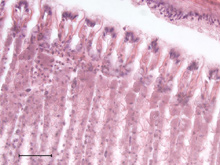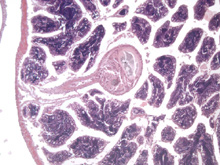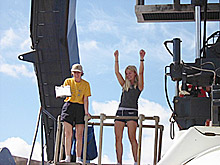
(Left to right) Chief Scientist Carolyn Ruppel and William and Mary undergraduate Anne Mills, standing on the Alvin catwalk with pilot Bruce Strickrott, after their dive on the Blake Ridge Diapir. Photo courtesy of Amy Eisin. Click image for larger view.
An Exciting Weekend of Firsts at The Blake Ridge Diapir
July 27, 2003
Dr. Carolyn Ruppel, Co-Chief Scientist
Associate Professor
Georgia Institute of Technology
Catalina Martinez, Mission Coordinator
NOAA Office of Ocean Exploration
“Waves of clams as far as we could see,” was how Chief Scientist Carolyn Ruppel described what she saw during her first dive in the DSV Alvin at the Blake Ridge Diapir, a site she has studied for many years as a geophysicist. Although Carolyn is a veteran of many scientific cruises, Alvin dive 3910 was her inauguration into the world of deep sea human-occupied submersibles. It was also the first time she was able to visit this geologically distinct region of the seafloor, an area she first studied as a postdoctoral researcher at Woods Hole Oceanographic Institution and then revisited as a shipboard scientist on the Ocean Drilling Program investigation of the diapir and on the 2001 NOAA/NURP cruise.
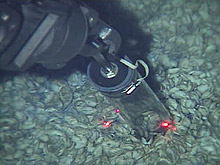
A push core inserted into a dense bed of vesicomyid clams at Blake Ridge Diapir at 2,169 m. Photo courtesy of WHOI. Click image for larger view.
Carolyn experienced her first Alvin dive with undergraduate student Anne Mills as the starboard observer, and Alvin pilot and Expedition Leader, Pat Hickey. After both Carolyn and Anne recovered from their traditional ice-cold seawater dive initiations, Anne jumped around the deck with enthusiasm, exclaiming that the dive was “absolutely awesome!” Anne described their sighting of methane hydrate, and said they could see gas bubbling up from the sediment in many areas. She told us that when they took push core samples in these regions, gas bubbles could be seen escaping around the periphery of the cores. “It was as if we made our very own methane seeps!” reported Anne. Anne will soon be entering her senior year at The College of William and Mary, and she has worked in Cindy Van Dover’s lab for the past two years. Anne is one of several students on this expedition relying on the collection of live vesicomyid clams, as her senior thesis work will be to investigate parasite burdens and disease prevalence in these tiny white clams associated with the methane seeps at the Blake Ridge.
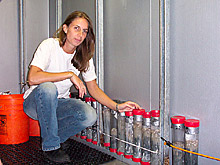
Graduate student Taylor Heyl sorting push cores taken from vesicomyid clam beds at the Blake Ridge Diapir. Photo courtesy of M. Olsen. Click image for larger view.
Although this was the second 2003 dive on the Blake Ridge Diapir, it brought just as much excitement as the first. Once the sub was recovered safely, and the new Alvin divers properly initiated, the science party crowded the deck to get a closer look at the Alvin basket full of samples. “Are the clams alive?” asked graduate student Taylor Heyl, as her Master’s Thesis research also depends on the live collection of the vesicomyid clams. During Taylor’s dive the previous day at the Blake Ridge Diapir, several push cores were taken in what appeared to be live clam beds, but all that was recovered were empty shells. With each dive, the pilots and observers accumulate knowledge that assists in targeting live clams on the next dive. Recovering live clams from the large swaths that stretch for tens of meters has proved difficult. Most successful recoveries were in push cores and slurp samples from the center of small, isolated clam patches. The scientists believe that such patches mark the location of sulfide seeps that the clams need to live.
Taylor was thrilled to learn that most of the push cores used to collect clams during today’s dive contained live clams of all sizes, as did a ‘slurp’ sample from a large clam bed. Taylor’s first experience on the R/V Atlantis occurred last year during the OE sponsored Gulf of Alaska Seamount Exploration cruise while she was working in Kodiak, Alaska, as a biologist for the National Marine Fisheries Service. Taylor is now a first year graduate student in the lab of co-Chief Scientist Cindy Van Dover at The College of William and Mary, where she continues to explore deep sea biology with a focus in reproductive biology of vesicomyid clams and related sediment geochemistry.
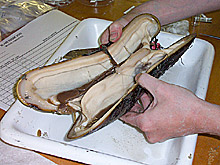
This giant mussel was collected at the Blake Ridge Diapir. The gut and surrounding tissue will be dissected from the rest of the mussel for post-cruise analysis. Photo courtesy of M. Olsen. Click image for larger view.
Working Around The Clock
Dr. Carolyn Ruppel, Co-Chief Scientist
Associate Professor
Georgia Institute of Technology
Catalina Martinez, Mission Coordinator
NOAA Office of Ocean Exploration
As soon as Alvin is on deck, the various scientific groups scatter to different labs. Van Doverís group dissects, sorts, photographs, and preserves organisms, extracts live clams from push cores, and measures geochemical parameters in the sediments beneath the clams. The overnight crew of geophysicists return to the seafloor mapping operation. The microbiologists and the geochemists begin the slow process of extracting pore water from thin slices of sediments and preserving subsamples for later DNA analysis.
Squeezing pore waters from push cores is one of the most time-consuming and labor-intensive scientific activities on this cruise and the team works until Alvin leaves the deck for the next dive the following morning. Cores are collected in a variety of habitats on each dive, and the top of the cores may contain live, dead, and mixed clam beds; bacterial mats; and worms in tubes. Mesh sieves are used to collect organisms that inhabit the top few centimeters of sediment.
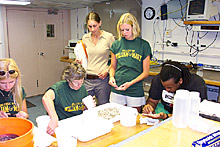
Cindy Van Dover (seated at center), working with students (from left to right) Anne Mills, Taylor Heyl, Julianne Pupa, and John Braxton, dissecting vesicomyid clams. Photo courtesy of M. Olsen. Click image for larger view.
The pore waters in the sediments recovered in the push cores contain important geochemical clues about microbial processes close to the seep site. The sediments are first extruded from the push core in 2 centimeter intervals in a nitrogen atmosphere. Each subsection is sealed in an airtight nylon squeezer and then pressurized at 50 psi (pounds per square inch) with bottled nitrogen. Nitrogen prevents reaction of the sediment or pore waters with air. The pore water samples will later be used for sulfate, sulfide, and sulfur isotope analyses by Bill Gilhooly, a PhD student in the laboratory of Dr. Stephen Macko at the University of Virginia.
The clam and mussel dissections also occupy a great deal of time on the part of many students, as well as co-Chief Scientist, Cindy Van Dover. She and College of William and Mary graduate and undergraduate students, as well as several other late-night volunteers, work side-by-side sieving clams and other organisms from the top layers of the sediment cores. Tiny white clams are collected and counted, and whole clam tissues are dissected from their fragile shells and preserved for later microscopic examination, as well as for whole dry weights. Commensal worms found within these deep sea bivalves are also collected for positive identification back in the lab.
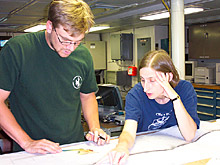
Graduate student Matt Hornbach and Chief Scientist Carolyn Ruppel discussing a profile of the Blake Ridge Diapir. Photo courtesy of M. Olsen. Click image for larger view.
Each night the geophysics group (Chief Scientist Carolyn Ruppel, collaborating scientist Steve Holbrook from the University of Wyoming, and his PhD student Matt Hornbach) acquire Seabeam and Chirp data to search for gas seeps, map geologic features, and choose potential dive targets. This task is so time-consuming that Matt is rarely seen outside the computer lab except during meal-times!
As the day comes to a close, the scientists are full of energy and enthusiasm for the work that lies ahead. We are currently heading north and mapping the seafloor on the way to the first-ever dive on the Cape Fear Diapir. Please stay tuned!
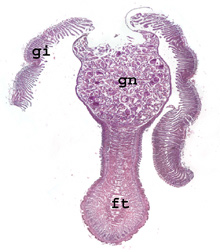
Cross-section through a female vesicomyid clam. gn=gonad, gi=gill, ft=foot. Click image for larger view.
Vesicomyid Clam Anatomy: A Histological Look at Some of the Blake Ridge Bivalves
Anne Mills
Undergraduate Student
The College of William and Mary
Along with mussels and worms in tubes, beds of vesicomyid clams blanket the sediments at the Blake Ridge diapir. These clams exhibit modifications appropriate for existence in the chemosynthetically fueled environment of a cold seep. Vesicomyid clams use their highly muscular feet both in anchorage and in the absorption of sulfides from the surrounding sediments.
More information on clams and their symbols.
Unlike the mussels at Blake Ridge, which have two types of symbionts (organisms living within other organisms in a mutually beneficial relationship), the vesicomyid clams harbor only sulfide-oxidizing (thiotrophic) bacteria (sulfur oxidation is a chemical reaction that occurs when an organism absorbs sulfur and breaks it down to a useable product). These bacteria allow the clams to take advantage of the high levels of sulfides—normally toxic to living organisms—present at deep-sea cold seeps. The gills of the clams are rich with thiotrophic symbionts and are enlarged to increase absorption and oxidation of sulfides by these bacteria.
The relationship between the bacteria and the clams is mutually beneficial; the pumping of the ciliated clam gills provides the bacteria with increased access to oxygen and sulfides, while the energy derived from the bacteria allows the vesicomyids to thrive in an otherwise low-nutrient environment. The presence of sulfide-oxidizing gill symbionts and scarcity of food particles in the surrounding water decreases the importance of the gut in nutrient-uptake, which is evidenced by the severe reduction of the clam's gut compared to related clams that lack symbiotic associations.
The combination of symbiont associations, reduced gut, and increased gill size makes the morphology of these clams optimal for their specialized niche at the cold seeps of the deep sea.




















